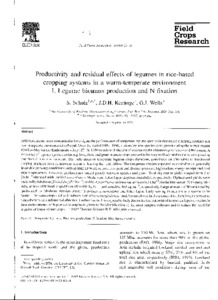| dc.contributor.author | Schulz, S. |
| dc.contributor.author | Keatinge, J.D.H. |
| dc.contributor.author | Wells, G.J. |
| dc.date.accessioned | 2019-12-04T11:22:30Z |
| dc.date.available | 2019-12-04T11:22:30Z |
| dc.date.issued | 1999 |
| dc.identifier.citation | Schulz, S., Keatinge, J.D.H. & Wells, G.J. (1999). Productivity and residual effects of legumes in rice-based cropping systems in a warm-temperate environment: I. Legume biomass production and N fixation. Field Crops Research, 61(1), 23-35. |
| dc.identifier.issn | 0378-4290 |
| dc.identifier.uri | https://hdl.handle.net/20.500.12478/4021 |
| dc.description.abstract | Field experiments were conducted to investigate the performance of temperate legume species in rice-based cropping systems in a warm-temperate environment in Nepal. Over the period 1994–1996, various legume species were grown during the winter season (October–May) in the Kathmandu valley (27° N, 1350 m asl) with the aim of evaluating their biomass production and N fixation. A wide range of legume species including food, feed and green manure crops proved to be very well adapted to the winter growing conditions in this environment. The cultivation of temperate legume crops therefore, constitutes an alternative to traditional cropping practices such as growing wheat or leaving the land fallow. The temperate species appeared to capitalise on generally favourable growing conditions such as long growing season, low pest and disease pressure, high radiant energy receipt and cool night temperatures. However, performance varied greatly between species and years. Total dry matter yields ranged from 2 to 20 t ha−1 obtained with lentil (Lens culinaris Medic) and bitter lupin (Lupinus mutabilis), respectively. Highest seed yields were produced by fababean (Vicia faba) (5 t ha−1) and field pea (Pisum sativum var. arvense) (3 t ha−1) in the first season. Nitrogen yields and quantities of N fixed ranged from 18 to 481 kg ha−1 and from 0 to 463 kg ha−1, respectively. Large amounts of N were fixed by species such as fababean, Persian clover (Trifolium resupinatum) and bitter lupin. Early sowing in autumn was shown to be beneficial for some crops such as fababean, vetch (Vicia benghalensis) and Persian clover. In these cases, it is, therefore, important to reduce the turn-around interval after rice. Further research is required to fully determine the potential of temperate legume species in these environments with particular emphasis given to the identification of the most adapted cultivars and to reduce the need for irrigation of these winter crops. |
| dc.language.iso | en |
| dc.subject | Legumes |
| dc.subject | Biomass |
| dc.subject | Cropping Systems |
| dc.subject | Green Manures |
| dc.title | Productivity and residual effects of legumes in rice-based cropping systems in a warm-temperate environment I. Legume biomass production and N fixation |
| dc.type | Journal Article |
| dc.description.version | Peer Review |
| cg.contributor.affiliation | University of Reading |
| cg.contributor.affiliation | International Institute of Tropical Agriculture |
| cg.coverage.region | Asia |
| cg.coverage.region | South Asia |
| cg.coverage.country | Nepal |
| cg.isijournal | ISI Journal |
| cg.authorship.types | CGIAR and advanced research institute |
| cg.iitasubject | Grain Legumes |
| cg.iitasubject | Crop Systems |
| cg.accessibilitystatus | Limited Access |
| local.dspaceid | 99307 |

